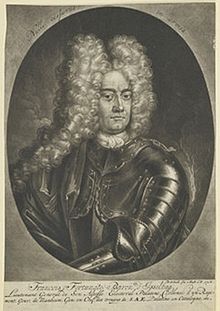Franz Fortunat von Isselbach

Franz Fortunat von Isselbach (born February 13, 1663 , † August 19, 1734 in Mannheim ) was a baron and general field master of the Palatinate and Imperial Army .
Life
Little is known about his origin and his life. As a lieutenant colonel in the Herberstein Regiment , Emperor Leopold I accepted him into this class of aristocracy on November 19, 1698, citing the allegedly traditional baron class. During the Thirty Years' War a Georg Friedrich von Isselbach appears as a councilor in the Bavarian service, who is probably his ancestor.
On October 8, 1704, Franz Fortunat von Isselbach was promoted to imperial general field sergeant , then to lieutenant general of the Electorate of the Palatinate . In the War of the Spanish Succession he fought under Prince Eugene of Savoy on the Italian theater of war, where he stood out in September 1706 at the Battle of Turin and in November of that year took the besieged city of Tortona . In this war he became a field marshal lieutenant . 1706–1714 Isselbach officiated as military governor of Heidelberg . Franz Fortunat von Isselbach received on August 19, 1717 the appointment of imperial, and soon after that also of the Electorate of the Palatinate General Feldzeugmeister and governor of Mannheim . From 1721 he acted as commander in chief of the Electoral Palatinate Army .
Around 1714 Isselbach acquired Bertoldsheim Castle and had it converted from 1717–1730 by the builder Gabriel de Gabrieli into a representative baroque palace that still exists today. He also owned the villages of Trugenhofen and Natterholz . From 1728 to 1733 he also owned the Dienheimer Hof in Bad Kreuznach on a lease basis .
General von Isselbach died in Mannheim on August 19, 1734; the contemporary obituary by Michael Ranft describes him as the “most distinguished general in the service of the Electorate of the Palatinate” . His grave with epitaph was in the no longer existing Capuchin Church in Mannheim , the epitaph inscription is handed down in the " Thesaurus Palatinus " by Johann Franz Capellini von Wickenburg .
literature
- Michael Ranft : The genealogical Archivarius , IX. Teil, Leipzig, 1734, p. 482 u. 483 (digital scan)
- Ernst Heinrich Kneschke: New General German Adels Lexicon , Volume 4, p. 598, Leipzig, 1863; (Digital scan)
- Johann Matthias Steudlin: Lettres et memoires du Baron de Pollnitz , Frankfurt, 1738; (Digital scan)
- Mannheimer Geschichtsblätter: Monthly for the history, antiquity and folklore of Mannheim and the Palatinate , New Series, Volume 1, 1994, p. 144; (Detail scan)
Web links
Individual evidence
- ^ Karl Friedrich von Frank: Status surveys and acts of grace for the German Reich , Volume 2, p. 254, Senftenegg Castle, Lower Austria, 1970; (Detail scan)
- ^ Website on Georg Friedrich von Isselbach
- ^ Johann Christian Herchenhahn : History of the government of Emperor Joseph, the First , Crusius Verlag, Leipzig, 1786, p. 745 u. 746; (Digital scan)
- ↑ History of the Imperial and Royal Infantry Regiment Leopold II, King of the Belgians, No. 27 of its establishment from 1682 to 1882, 1882, p. 121; (Detail scan)
- ^ Website of the Heidelberg History Association
- ^ Website on Bertoldsheim Castle
- ^ Walther Zimmermann : Die Kunstdenkmäler des Kreis Kreuznach , new edition, Deutscher Kunstverlag, 1972, p. 98, ISBN 3-422-00540-4 ; (Detail scan)
- ↑ View of the Dienheimer Hof in Bad Kreuznach ( memento of the original from July 14, 2013 in the Internet Archive ) Info: The archive link has been inserted automatically and has not yet been checked. Please check the original and archive link according to the instructions and then remove this notice.
- ↑ Digital scan from the Thesaurus Palatinus
| personal data | |
|---|---|
| SURNAME | Isselbach, Franz Fortunat from |
| BRIEF DESCRIPTION | German baron and general field master |
| DATE OF BIRTH | February 13, 1663 |
| DATE OF DEATH | August 19, 1734 |
| Place of death | Mannheim |